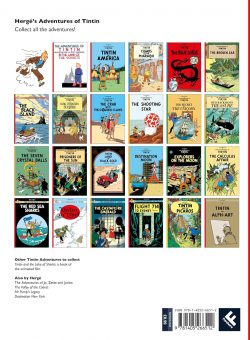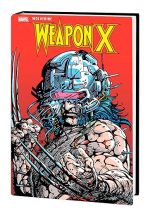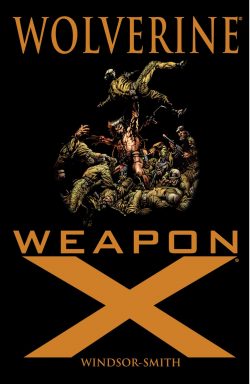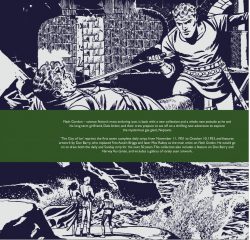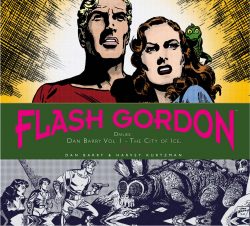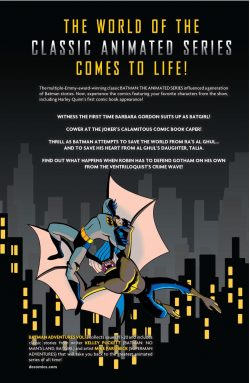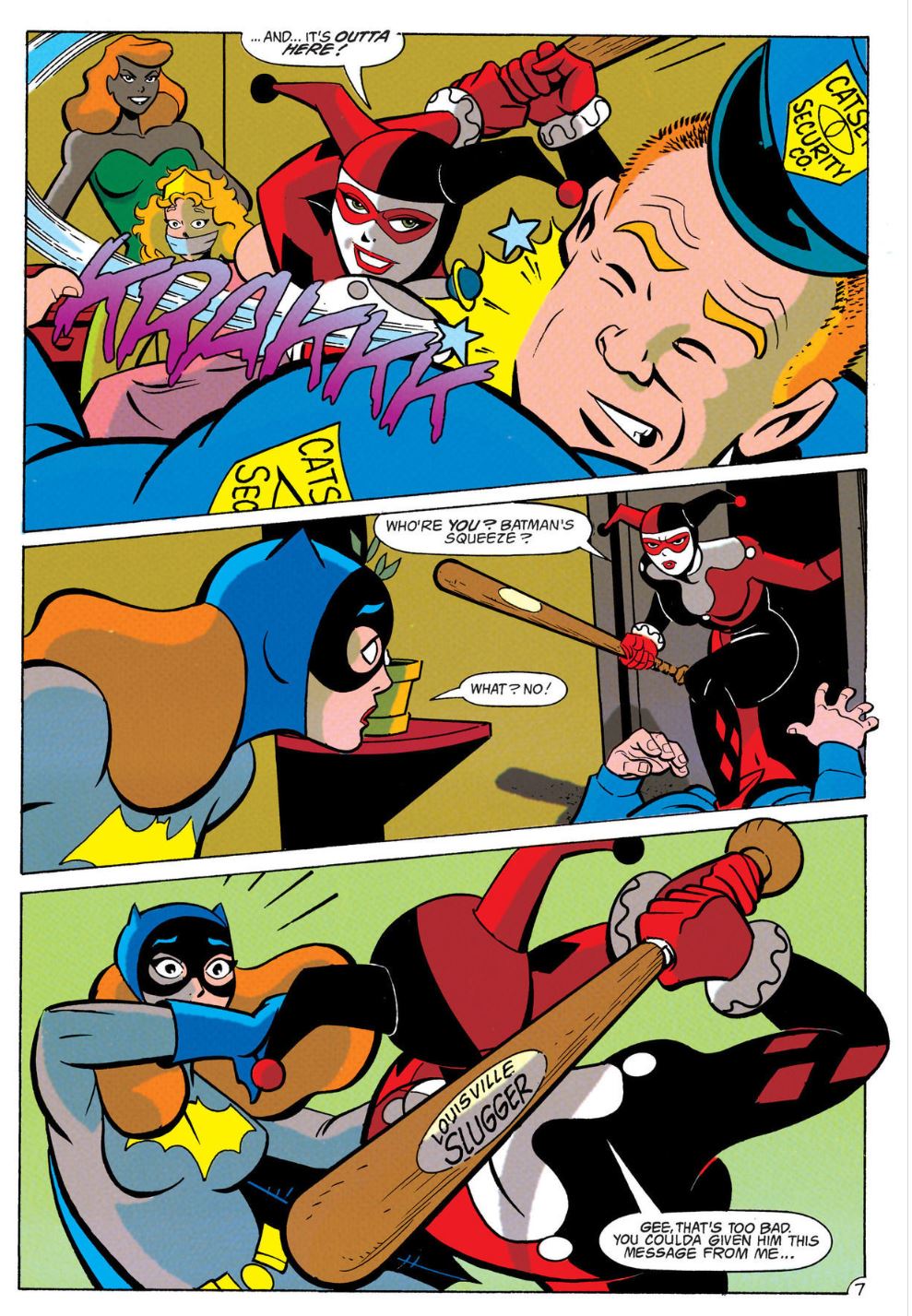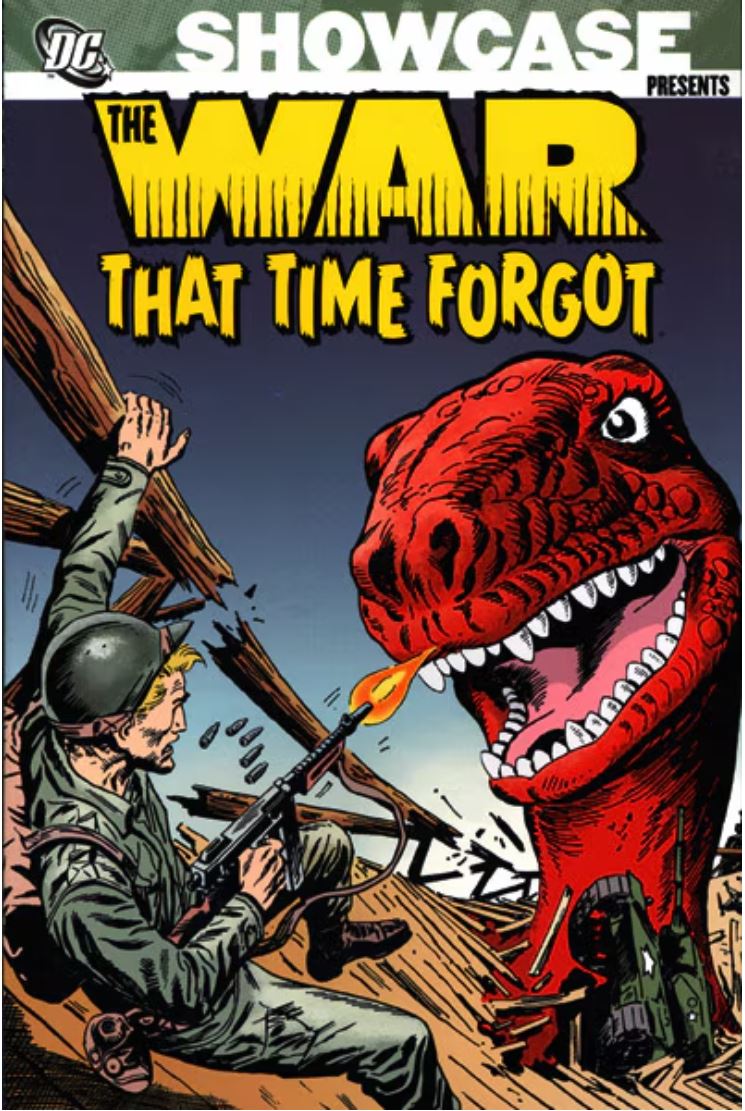
By Robert Kanigher, Ross Andru & Mike Esposito, Russ Heath, Gene Colan, Joe Kubert & various (DC Comics)
ISBN: 978-1-4012-1253-7 (TPB)
Unbelievably, STILL not a Major Motion Picture, The War That Time Forgot debuted in Star Spangled War Stories #90 and ran wild there until #137 (May 1968). It skipped only three issues: #91, 93 & 126, the last of which starred the United States Marine Corps simian Sergeant Gorilla. Look it up: I’m neither kidding nor being metaphorical…
At present this stunningly bizarre black-&-white compendium is the only comprehensive collection: gathering together most but not all of the monstrously madcap material from SSWS #90, 92, 94-125 and 127-128, cumulatively spanning April/May 1960 to August 1966. Simply too good a concept to leave alone, this seamless, shameless blend of Sir Arthur Conan Doyle’s Lost World and Edgar Rice Burroughs’ Caprona stories (known alternatively as the Caspak Trilogy or The Land That Time Forgot) provided everything baby-boomer boys – and surely many girls too, if truth be told – could dream of with giant lizards, humongous insects, fantastic adventures and two-fisted heroes employing lots of guns and gear and explodey stuff…
Robert Kanigher (1915-2002) was one of the most distinctive authorial voices in American comics, blending rugged realism with fantastic fantasy in his signature War comics, Horror stories, Romance, superhero titles such as Wonder Woman, Teen Titans, Hawkman, Metal Men, Iron Man, Lois Lane, Steel Sterling, Batman and other genres and stars too numerous to cover here. He scripted ‘Mystery of the Human Thunderbolt’ – the first story of the Silver Age which introduced Barry Allen as The Flash to the superhero-hungry kids of the World in 1956.
Kanigher sold his first stories and poetry in 1932, wrote for the theatre, film and radio, and joined the Fox Features shop where he created The Bouncer, Steel Sterling and The Web, whilst providing scripts for Blue Beetle and the original (Shazam!-fuelled) Captain Marvel. In 1945 he settled at All-American Comics as both writer and editor, staying on when the company amalgamated with National Comics to become the forerunner of today’s DC. He scripted Golden Age iterations of Flash and Hawkman, created Black Canary, Dr. Pat and Lady Cop, plus memorable female foes Harlequin and Rose and Thorn. This last he reconstructed during the relevancy era of the early 1970s into a schizophrenic crime-busting superhero.
When mystery-men faded out at the end of the 1940s, Kanigher moved into westerns and war stories, and in 1952 became writer/editor of the company’s combat titles All-American War Stories, Star Spangled War Stories and Our Amy at War. He launched Our Fighting Forces in 1954 and added G.I. Combat to his burgeoning portfolio when Quality Comics sold their line of titles to DC in 1956, all the while working on Wonder Woman, cowboy Johnny Thunder, Rex the Wonder Dog, Silent Knight, Sea Devils, The Viking Prince and a host of others.
Among his many epochal war series were Sgt. Rock, Enemy Ace, The Haunted Tank and The Losers as well as the visually addictive, irresistibly astonishing “Dogfaces vs Dinosaurs” dramas depicted here. Kanigher was a restlessly creative writer and I suspect he used this uncanny but formulaic adventure arena as a personal try-out venue for his many series concepts. The Flying Boots, G.I. Robot, Suicide Squad and many other teams and characters initially appeared in this lush Pacific hellhole with wall-to-wall danger. Indisputably, the big beasts were the stars, but occasionally ordinary G.I. Joes made enough of an impression to secure return engagements, too…
The wonderment commenced in Star Spangled War Stories #90 as paratroopers and tanks of the “Question Mark Patrol” are dropped on Mystery Island – from whence no American soldiers have ever returned. The crack warriors discover why when the operation is assaulted by pterosaurs, tyrannosaurs and worse on the ‘Island of Armoured Giants!’ Each yarn is superbly rendered by veteran art team Ross Andru & Mike Esposito.
Larry and Charlie, sole survivors of that first foray, returned to the lost world in #92’s ‘Last Battle of the Dinosaur Age!’ when aquatic beasts attack their rescue submarine forcing them back to the lethal landmass. ‘The Frogman and the Dinosaur!’ takes up most of SSWS #94 as a squad of second-rate Underwater Demolitions Team divers are trapped on the island, encountering the usual bevy of blockbuster brutes and a colossal crab as well.
What starts out as paratroopers versus pterodactyls in #95 turns into a deadly turf-war in ‘Guinea Pig Patrol!’ before ‘Mission X!’ introduces the Task Force X/Suicide Squad in a terse infiltration story with the increasing eager US military striving to set up a base on the strategically crucial monster island. The Navy took the lead in #97’s ‘The Sub-Crusher!’ with equally dire results as a giant gorilla joins the regular roster of horrors, after which a frustrated palaeontologist is blown off course and into his wildest nightmare in ‘The Island of Thunder’. The rest of his airborne platoon aren’t nearly as excited at the discovery…
The Flying Franks were a trapeze family before the war, but as “The Flying Boots” Henny, Tommy & Steve won fame as paratroopers. For #99’s ‘The Circus of Monsters!’ they face the greatest challenge of their lives after washing up on Mystery Island and narrowly escaping death by dinosaur. They aren’t too happy on being sent back next issue to track down a Japanese secret weapon in ‘The Volcano of Monsters!’
In #101 ‘The Robot and the Dinosaur!’ ramp up the fantasy quotient as reluctant Ranger Mac is dispatched to the primordial preserve to field-test the Army’s latest weapon: a fully automatic, artificial G.I. Joe, who promptly saves the day and returned to fight a ‘Punchboard War!’ in the next issue: tackling immense killer fish, assorted saurians and a giant Japanese war-robot that dwarfs the dinosaurs. The mecha-epic carried over and concluded in #103’s ‘Doom at Dinosaur Island!’, after which the Flying Boots encored in Star Spangled #104’s ‘The Tree of Terror!’ when a far-ranging pterodactyl drags the brothers back to the isle of no return for another explosive engagement. ‘The War on Dinosaur Island!’ sees the circus boys leading a small-scale invasion, but even tanks and the latest ordnance prove little use against pernicious, eternally hungry reptiles, after which ‘The Nightmare War!’ sees a dino-phobic museum janitor trapped in his worst nightmare. At least he has his best buddies and a goodly supply of bullets and bombs with him…
The action shifts to the oceans surrounding the island for sub-sea shocker ‘Battle of the Dinosaur Aquarium!’ with plesiosaurs, titanic turtles, colossal crabs and crocodilians on the menu, before hitting the beaches in #108 for ‘Dinosaur D-Day!’ when the monsters take up residence in the Navy’s landing craft. ‘The Last Soldiers’ then pits determined tank-men against a string of scaly perils on land, sea and air, after which a new Suicide Squad debuts in #110 to investigate a ‘Tunnel of Terror’ into the lost land of giant monsters. This time, though, there’s a giant gorilla on their side…
That huge hairy beast is the star of ‘Return of the Dinosaur Killer!’ as the harried unit leader and a wily boffin (visually based on Kanigher’s office associate Julie Schwartz) struggle to survive on the tropically reptilian atoll, whilst ‘Dinosaur Sub-Catcher!’ shifts locale to ice floes as a pack of lost sea dinosaurs attack a polar submarine and US weather station.
Star Spangled War Stories #113 returned to the blue Pacific for ‘Dinosaur Bait!’ and a pilot tasked with hunting down the cause for so many lost subs after which ‘Doom Came at Noon!’ revisits snowy climes as dinosaurs inexplicably rampage through alpine territory, making temporary allies of old enemies dispatched to destroy hidden Nazi submarine pens.
Issue #115’s ‘Battle Dinner for Dinosaurs!’ sees a helicopter pilot marooned on Mystery Island drawn into a spectacular aerial dogfight, before a duo of dedicated soldiers faced ice-bound beasts in ‘The Suicide Squad!’ The big difference being that here Morgan and Mace are more determined to kill each other than accomplish their mission…
‘Medal for a Dinosaur!’ bowed to the inevitable and introduced a (relatively) friendly baby pterodactyl to balance out Mace & Morgan’s barely-suppressed animosity, and ‘The Plane-Eater!’ finds the army odd couple adrift in the Pacific and in deep danger until our leather-winged little guy turns up once more…
The Suicide Squad were getting equal billing by the time of #119’s ‘Gun Duel on Dinosaur Hill!’, as yet another group of men-without-hope battle saurian horrors and each other to the death, after which the apparently un-killable Morgan & Mace pop back with Dino, the flying baby dinosaur. They also make a new ally and companion in handy hominid Caveboy, before the whole unlikely ensemble struggle to survive increasingly outlandish creatures in ‘The Tank Eater!’ Star Spangled War Stories #121 then presented another diving drama as a UDT frogman gains a Suicide Squad berth, proving to be a formidable fighter and ultimately ‘The Killer of Dinosaur Alley!’ Increasingly, G.I. hardware and ordnance began to gain the upper hand over bulk, fang and claw and much-missed representational maestro Russ Heath added an edge of hyper-realism to #122’s ‘The Divers of Death’ wherein two Frogman siblings battle incredible underwater insects but still can’t win the respect of their landlubber older brothers, and Gene Colan illustrated aquatic adventure ‘The Dinosaur who Ate Torpedoes!’, before Andru & Esposito reenlisted to depict ‘Terror in a Bottle!’. This was the second short saurian saga to grace issue #123 and another outing for that giant ape who loved to pummel pterosaurs and larrup lizards.
Undisputed master of gritty fantasy art Joe Kubert added his pencil-and-brush magic to tense and manic thriller ‘My Buddy the Dinosaur!’ in #124, and stuck around to illumine the return of G.I. Robot in stunning battle bonanza ‘Titbit For a Tyrannosaurus!’ (#125), after which Andru & Esposito limned Suicide Squad sea saga ‘The Monster Who Sank a Navy!’ in #127. The last tale here (#128) sees Colan resurface to illuminate a masterfully moving human drama actually improved by the inclusion of ravening reptiles in ‘The Million Dollar Medal!’.
Throughout this eclectic collection of dark dilemmas, light-hearted romps and spectacular battle blockbusters the emphasis is always on human fallibility; with soldiers unable to put aside long-held grudges, swallow pride or forgive trespasses even amidst the strangest and most terrifying moments of their lives, and this edgy humanity informs and elevates even the daftest of these wonderfully imaginative adventure yarns.
Classy, intense, insanely addictive and Just Plain Big Fun, The War that Time Forgot is a deliciously guilty pleasure and I for one hope the remaining stories from Star Spangled War Stories, Weird War Tales, G. I. Combat and especially the magnificent Tim Truman Guns of the Dragon miniseries all end up in sequel compilations before many more eons pass.
Now Read This book and you will too…
© 1960-1966, 2007 DC Comics. All Rights Reserved.






